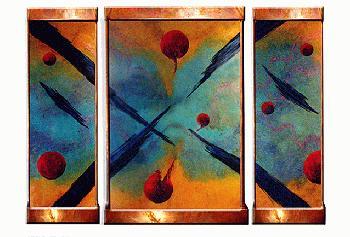 In the first part of this guide, we covered the parts of the garden that guide the logistical side of choosing the best fountain, which included the size, the style of the fountain's mounting, and the maintenance aspects. If you're curious about how those could effect your fountain choice, then it is best to go back and review the first part. In this part of the guide, we'll cover the materials that are used, the actual style of the fountain itself, and the different options that you might want to explore as you pick the right water feature for your space.
In the first part of this guide, we covered the parts of the garden that guide the logistical side of choosing the best fountain, which included the size, the style of the fountain's mounting, and the maintenance aspects. If you're curious about how those could effect your fountain choice, then it is best to go back and review the first part. In this part of the guide, we'll cover the materials that are used, the actual style of the fountain itself, and the different options that you might want to explore as you pick the right water feature for your space.
The Look
The classic, round basin fountain is a standard in terms of what we expect from a fountain, but there are actually many different looks that you can choose from. Ranging from antique, to modern, to even the futuristic, there's a wide array of visual designs, which include:
Free-standing wall fountains. These fountains offer vertical height, and can feature clear glass walls on both sides of the wall so that viewers can see through to the other side. Between the panes of tempered, durable glass, you can also see water that has been piped from the top to the bottom. The reservoir of a free standing fountain may be built into the base, creating a seamless presentation.
Tiered stone fountains, which can come in both rounded and geometric shapes. Stone is a very popular choice for outdoor garden fountains, and can take on unique characteristics matching their environment over time. Stone fountains can come in several different heights, but the tiered presentation is their most important aspect; both visually and aurally appealing, water falling over multiple levels is a classic choice that matches many different styles of garden.
Brass orb fountains, which feature a signature, large orb in the center of a basin. The basin itself can either be rounded, or it can be square, but the use of brass in the center creates enchanting light effects when the water reflects the light of the orb, and vice versa. You can create a dazzling display when using metal in areas of a garden that receive adequate sunlight.
Color Choices
 Along with other visual choices and cues, the color of the fountain can actually impact which type of feature will be most appropriate for your garden. If you decide to plant decorative trees that blossom pink or white, for example, then you may want to choose materials which compliment those colors. You can also choose fountains that are more suitable for your most visually impressive seasons; as an example, brass and copper can very nicely accent the look of an autumn garden. If your garden also grows with flourishes of gold during the spring and summer, then those metals are also suitable.
Along with other visual choices and cues, the color of the fountain can actually impact which type of feature will be most appropriate for your garden. If you decide to plant decorative trees that blossom pink or white, for example, then you may want to choose materials which compliment those colors. You can also choose fountains that are more suitable for your most visually impressive seasons; as an example, brass and copper can very nicely accent the look of an autumn garden. If your garden also grows with flourishes of gold during the spring and summer, then those metals are also suitable.
Stone can be a sort of “universal color,” as they tend toward shades of gray. The lighter the gray is, the easier it will be to match to the shades that your garden will put on display.
